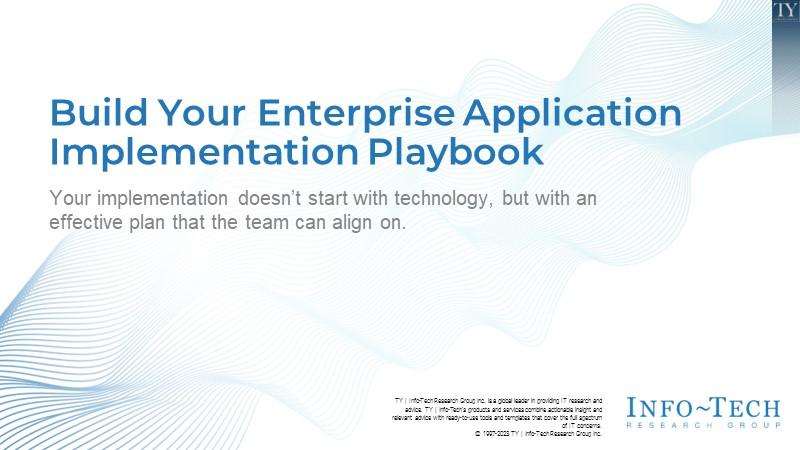
Optimize Your Software Selection Process: Why 5 and 30 Are the Magic Numbers
- Software selection takes forever. The process of choosing even the smallest apps can drag on for years: sometimes in perpetuity. Software selection teams are sprawling, leading to scheduling slowdowns and scope creep. Moreover, cumbersome or ad hoc selection processes lead to business-driven software selection.
Our Advice
Critical Insight
- Maximize project effectiveness with a five-person team. Project satisfaction and effectiveness is stagnant or decreases once the team grows beyond five people.
- Tight project timelines are critical. Keep stakeholders engaged with a defined application selection timeline that moves the project forward briskly – 30 days is optimal.
- Empower both IT and end users with a standardized selection process to consistently achieve high satisfaction coming out of software selection projects.
Impact and Result
- Shatter stakeholder expectations with truly rapid application selections.
- Put the “short” back in shortlist by consolidating the vendor shortlist up-front and reducing downstream effort.
- Identify high-impact software functionality by evaluating fewer use cases.
- Lock in hard savings and do not pay list price by using data-driven tactics.
Optimize Your Software Selection Process: Why 5 and 30 Are the Magic Numbers Research & Tools
Discover the Magic Numbers
Increase project satisfaction with a five-person core software selection team that will close out projects within 30 days.Besides the small introduction, subscribers and consulting clients within this management domain have access to:
- Optimize Your Software Selection Process: Why 5 and 30 Are the Magic Numbers Storyboard
1. Align and eliminate elapsed time
Ensure a formal selection process is in place and make a concerted effort to align stakeholder calendars.
2. Reduce low-impact activities
Reduce time spent watching vendor dog and pony shows, while reducing the size of your RFPs or skipping them entirely.
3. Focus on high-impact activities
Narrow the field to four contenders prior to in-depth comparison and engage in accelerated enterprise architecture oversight.
4. Use these rapid and essential selection tools
Focus on key use cases rather than lists of features.
- The Software Selection Workbook
- The Vendor Evaluation Workbook
- The Guide to Software Selection: A Business Stakeholder Manual
5. Engage Two Viable Vendors in Negotiation
Save more by bringing two vendors to the final stage of the project and surfacing a consolidated list of demands prior to entering negotiation.
Further reading
Optimize Your Software Selection Process: Why 5 and 30 Are the Magic Numbers
Select your applications better, faster, and cheaper.
How to Read This Software Selection Insight Primer
- 43,000 Data Points
- Aggregating Feedback
- Insights Backed by Data
This report is based on data gathered from a survey of 43,000 real-world IT practitioners.
The data is compiled from SoftwareReviews (a sister company of Info-Tech Research Group), which collects and aggregates feedback on a wide variety of enterprise technologies.
The insights, charts, and graphs in this presentation are all derived from data submitted by real end users.
The First Magic Number Is Five
The optimal software selection team comprises five people
- Derived from 43,000 data points. Analysis of thousands of software selection projects makes it clear a tight core selection team accelerates the selection process.
- Five people make up the core team. A small but cross-functional team keeps the project moving without getting bogged down on calendar alignment and endless back-and-forth.
- It is a balancing act. Having too few stakeholders on the core selection team will lead to missing valuable information, while having too many will lead to delays and politically driven inefficiencies.
There Are Major Benefits to Narrowing the Selection Team Size to Five
Limit the risk of ineffective “decision making by committee”
Expedite resolution of key issues and accelerate crucial decisions
Achieve alignment on critical requirements
Streamline calendar management
Info-Tech Insight
Too many cooks spoil the broth: create a highly focused selection team that can devote the majority of its time to the project while it’s in flight to demonstrate faster time to value.
Arm Yourself With Data to Choose the Right Plays for Selection
Software selection takes forever. The process of choosing even the smallest apps can drag on for years: sometimes in perpetuity.
Organizations keep too many players on the field, leading to scheduling slowdowns and scope creep. |
Keeping the size of the core selection team down, while liaising with more stakeholders and subject matter experts (SMEs), leads to improved results. |
Maximize project effectiveness with a five-person team. Project satisfaction and effectiveness are stagnant or decrease once the team grows beyond five people.
Cumbersome or ad hoc selection processes lead to business-driven software selection. |
Increase stakeholder satisfaction by using a consistent selection framework that captures their needs while not being a burden. |
Empower both IT and end users with a standardized selection process to consistently achieve high satisfaction coming out of software selection projects.
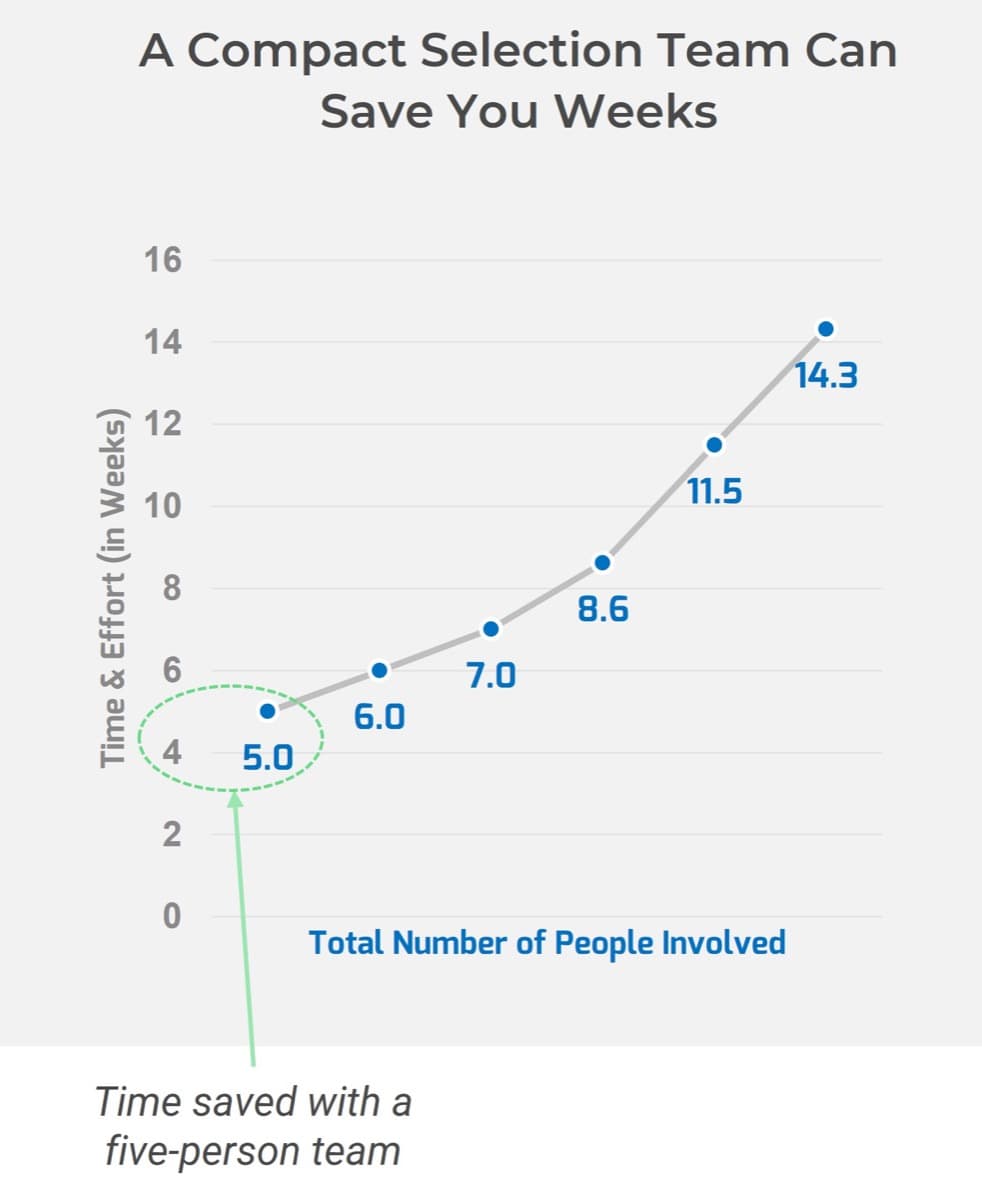
Project Satisfaction and Effectiveness Are Stagnant Once the Team Grows Beyond Five People

- There is only a marginal difference in selection effectiveness when more people are involved, so why include so many? It only bogs down the process!
- Full-time resourcing: At least one member of the five team members must be allocated to the selection initiative as a full-time resource.
Info-Tech Insight
It sounds natural to include as many players as possible in the core selection group; however, expanding the group beyond five people does not lead to an increase in satisfaction. Consider including a general stakeholder feedback working session instead.
Shorten Project Duration by Capping the Selection Team at Five People
However, it is important to make all stakeholders feel heard
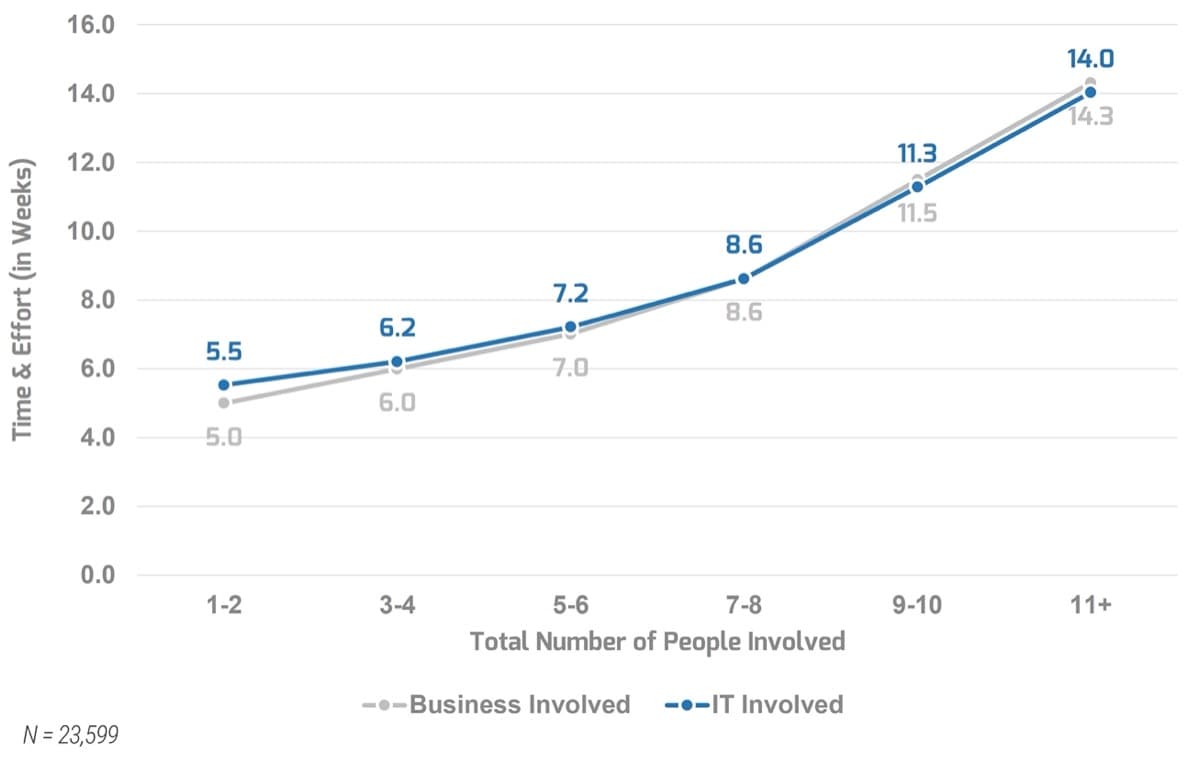
Exclusion is not the name of the game.
- Remember, we are talking about the core selection team.
- Help stakeholders understand their role in the project.
- Educate stakeholders about your approach to selection.
- Ensure stakeholders understand why the official selection team is being capped at five people.
- Soliciting requirements and feedback from a broader array of stakeholders is still critical.
Large Organizations Benefit From Compact Selection Teams Just as Much as Small Firms
Think big even if your organization is small
Small organizations
Teams smaller than five people are common due to limited resources.
Medium organizations
Selection project satisfaction peaks with teams of fewer than two people. Consider growing the team to about five people to make stakeholders feel more included with minimal drops in satisfaction.
Large organizations
Satisfaction peaks when teams are kept to three to five people. With many SMEs available, it is critical to choose the right players for your team.
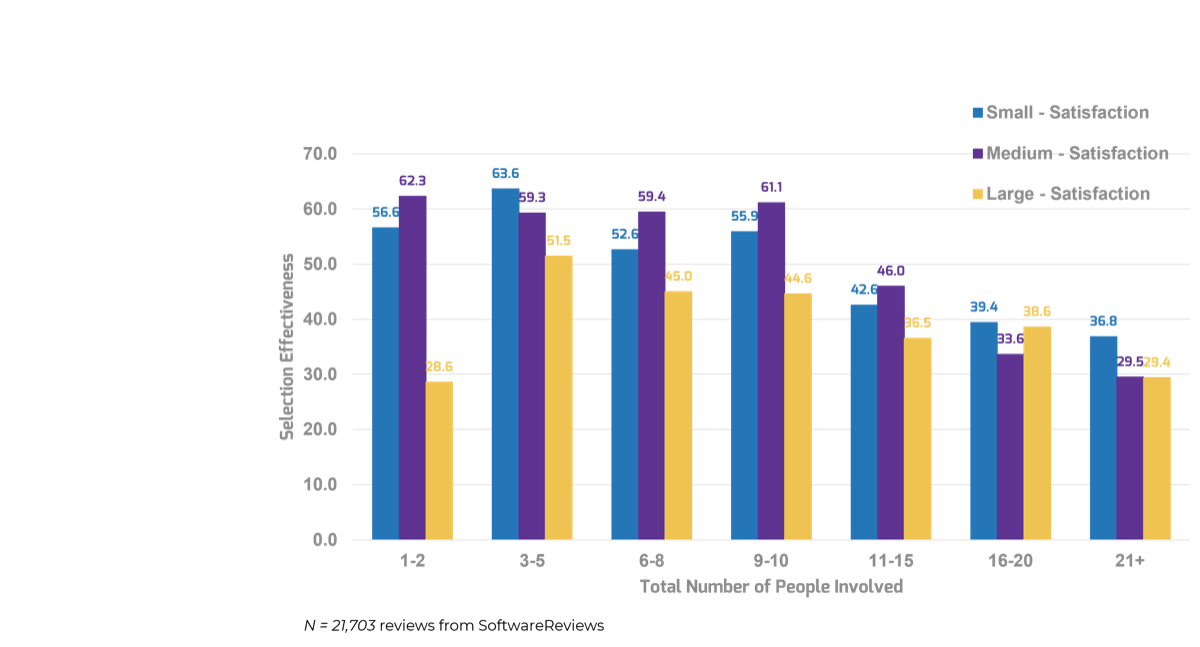
Keep the Core Selection Team to Five People Regardless of the Software Category
Smaller selection teams yield increased satisfaction across software categories
Info-Tech Insight
Core team size remains the same regardless of the application being selected. However, team composition will vary depending on the end users being targeted.
Think beyond application complexity
- Our instinct is to vary the size of the core selection team based on perceived application complexity.
- The data has demonstrated that a small team yields increased satisfaction for applications across a wide array of application complexity profiles.
- The real differentiator for complex applications will be the number of stakeholders that the core selection team liaise with, particularly for defining strong requirements.
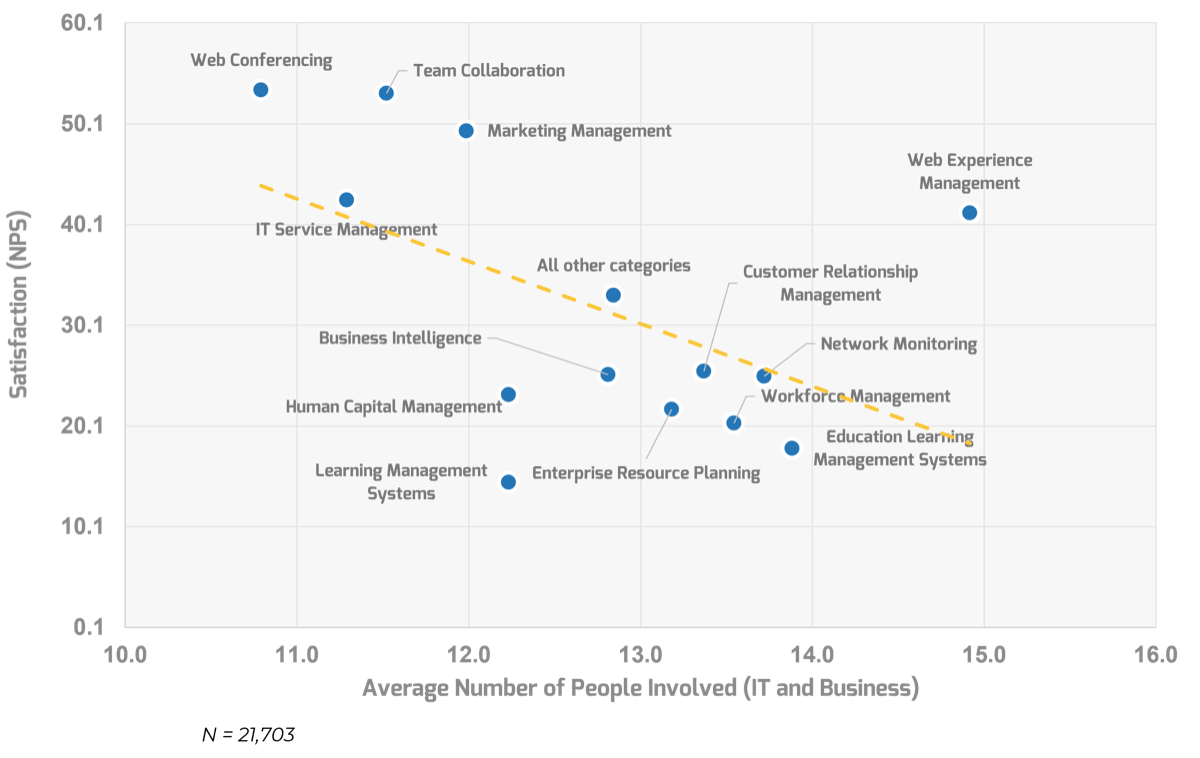
The Second Magic Number Is 30
Finish the project while stakeholders are still fully engaged in order to maximize satisfaction
- 30- to 60-day project timelines are critical. Keep stakeholders engaged with a defined application selection timeline that moves the project forward briskly.
- Strike while the iron is hot. Deliver applications in a timely manner after the initial request. Don’t let IT become the bottleneck for process optimization.
- Minimize scope creep: As projects drag on in perpetuity, the scope of the project balloons to something that cannot possibly achieve key business objectives in a timely fashion.
Aggressively Timeboxing the Project Yields Benefits Across Multiple Software Categories
After four weeks, stakeholder satisfaction is variable

Only categories with at least 1,000 responses were included in the analysis.
Achieve peak satisfaction by allotting 30 days for an application selection project.
- Spending two weeks or less typically leads to higher levels of satisfaction for each category because it leaves more time for negotiation, implementation, and making sure everything works properly (especially if there is a time constraint).
- Watch out for the “satisfaction danger zone” once project enters the 6- to 12-week mark. Completing a selection in four weeks yields greater satisfaction.
Spend Your Time Wisely to Complete the Selection in 30 Days
Save time in the first three phases of the selection project
Awareness |
Education & Discovery |
Evaluation |
|---|---|---|
Reduce Time |
Reduce Time |
Reduce Time |
| ↓ | ↓ | ↓ |
Save time duplicating existing market research. Save time and maintain alignment with focus groups. |
Save time across tedious demos and understanding the marketplace. |
Save time gathering detailed historical requirements. Instead, focus on key issues. |
Info-Tech Insight – Awareness
Timebox the process of impact analysis. More time should be spent performing the action than building a business case.
Info-Tech Insight – Education
Save time duplicating existing market research. Save time and maintain alignment with focus groups.
Info-Tech Insight – Evaluation
Decision committee time is valuable. Get up to speed using third-party data and written collateral. Use committee time to conduct investigative interviews instead. Salesperson charisma and marketing collateral quality should not be primary selection criteria. Sadly, this is the case far too often.
Limit Project Duration to 30 Days Regardless of the Application Being Selected
Timeboxing application selection yields increased satisfaction across software categories
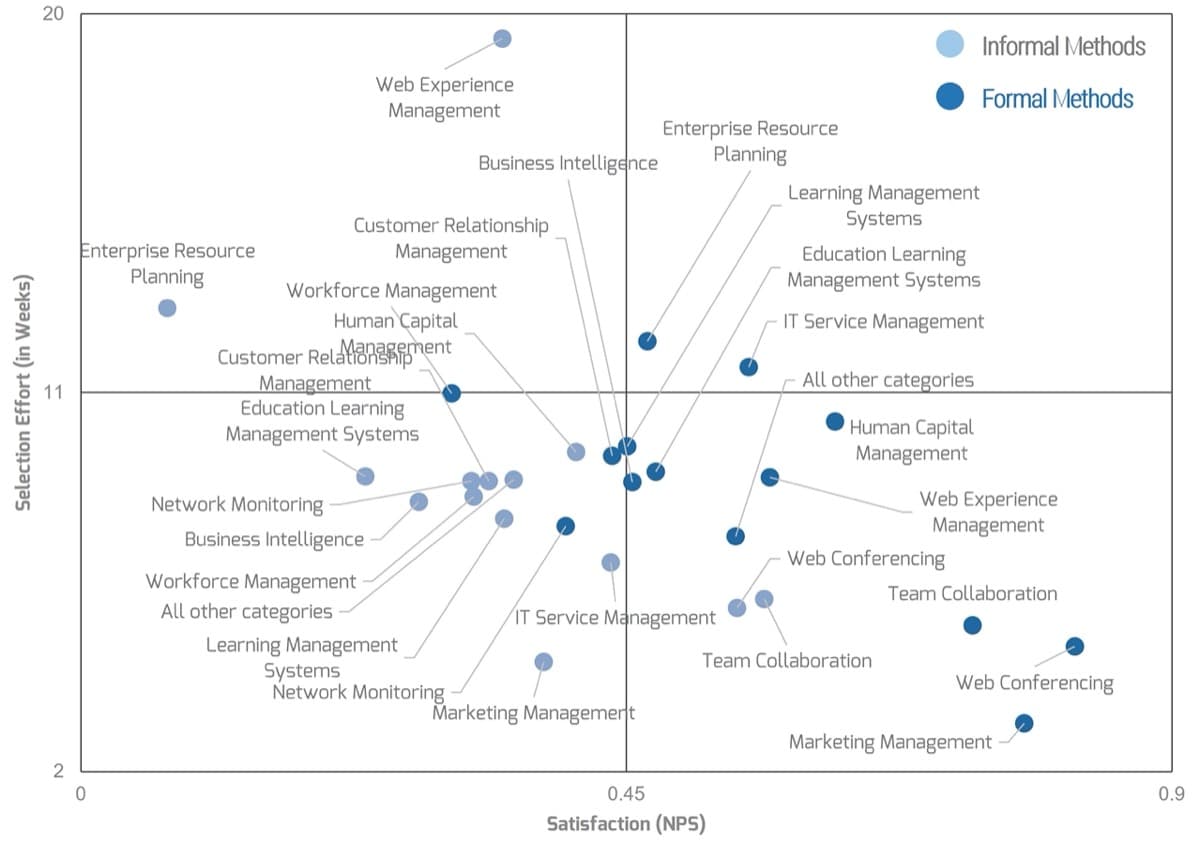
Info-Tech Insight
Office collaboration tools are a great case study for increasing satisfaction with decreased time to selection. Given the sharp impetus of COVID-19, many organizations quickly selected tools like Zoom and Teams, enabling remote work with very high end-user satisfaction.
There are alternative approaches for enterprise-sized applications:
- New applications that demand rigorous business process improvement efforts may require allotting time for prework before engaging in the 30-day selection project.
- To ensure that IT is using the right framework, understand the cost and complexity profile of the application you’re looking to select.
The Data Also Shows That There Are Five Additional Keys to Improving Your Selection Process
| 1. ALIGN & ELIMINATE ELAPSED TIME |
|
|---|---|
| 2. REDUCE TIME SPENT ON LOW-IMPACT ACTIVITIES |
|
| 3. FOCUS ON HIGH- IMPACT ACTIVITIES |
|
| 4. USE RAPID & ESSENTIAL ASSESSMENT TOOLS |
|
| 5. ENGAGE TWO VIABLE VENDORS IN NEGOTIATION |
|
1. Align & Eliminate Elapsed Time
✓ Ensure a formal selection process is in place.
✓ Reduce time by timeboxing the project to 30 days.
✓ Align the calendars of the five-person core selection team.
Improving Your IT Department’s Software Selection Capability Yields Big Results
Time spent building a better process for software selection is a great investment
- Enterprise application selection is an activity that every IT department must embark on, often many times per year.
- The frequency and repeatability of software selection means it is an indispensable process to target for optimization.
- A formal process is not always synonymous with a well-oiled process.
- Even if you have a formal selection process already in place, it’s imperative to take a concerted approach to continuous improvement.
It is critical to improve the selection process before formalizing
Leverage Info-Tech’s Rapid Application Selection Framework to gain insights on how you can fine-tune and accelerate existing codified approaches to application selection.
Before Condensing the Selection Team, First Formalize the Software Selection Process
Software selection processes are challenging
Vendor selection is politically charged, requiring Procurement to navigate around stakeholder biases and existing relationships. |
Stakeholders |
The process is time consuming and often started too late. In the absence of clarity around requirements, it is easy to default to looking at price instead of best functional and architectural fit. |
Timing |
Defining formal process and methodology
Formal selection methodologies are repeatable processes that anybody can consistently follow to quickly select new technology. |
Repeatable |
The goal of formalizing the approach is to enable IT to deliver business value consistently while also empowering stakeholders to find tools that meet their needs. Remember! A formal selection process is synonymous with a bureaucratic, overblown approach. |
Driving Value |
Most Organizations Are Already Using a Formal Software Selection Methodology
Don’t get left behind!
- A common misconception for software selection is that only large organizations have formal processes.
- The reality is that organizations of all sizes are making use of formal processes for software selection.
- Moreover, using a standardized method to evaluate new technology is most likely common practice among your competitors regardless of their size.
- It is important to remember that the level of rigor for the processes will vary based not only on project size but also on organization size.
Only categories with at least 1,000 responses were included in the analysis.
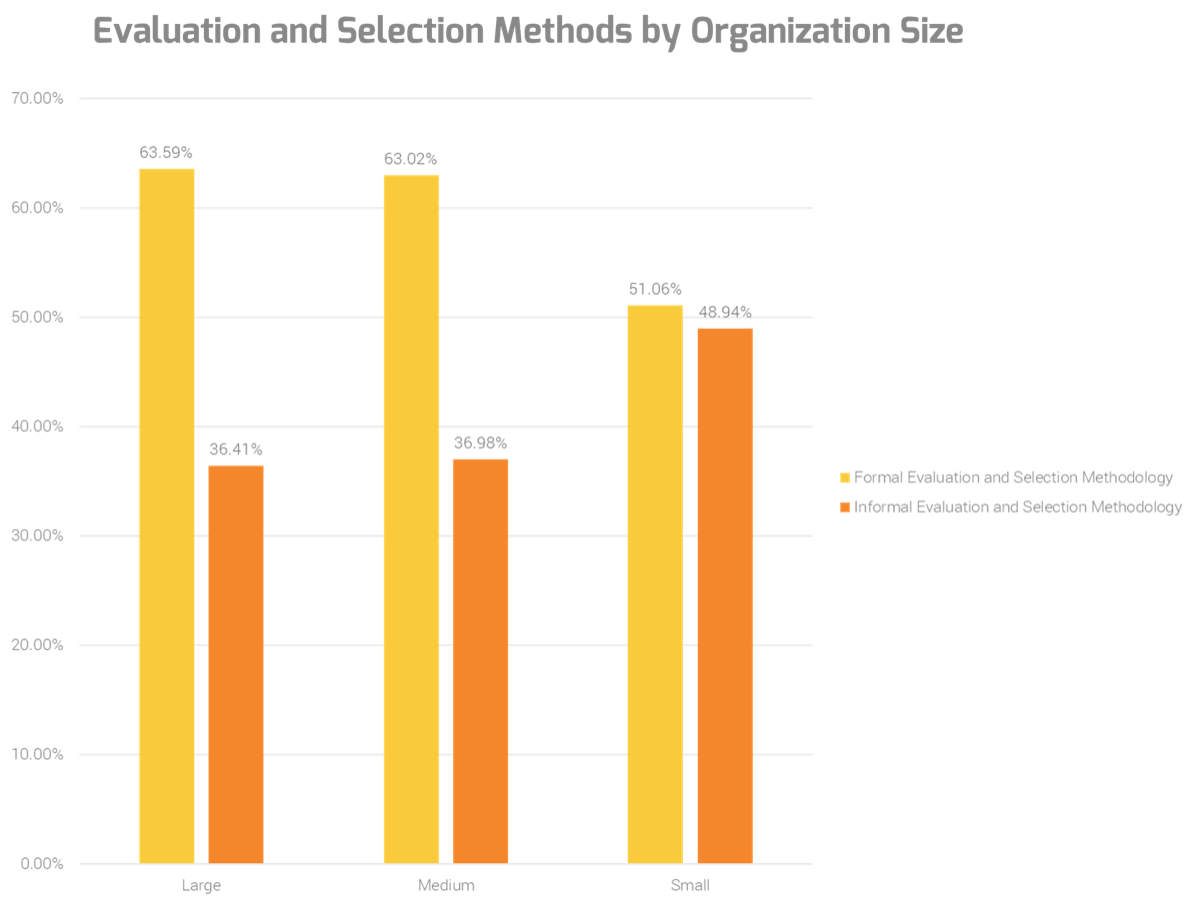
Use a Formal Evaluation and Selection Methodology to Achieve Higher Satisfaction
A formal selection process does not equal a bloated selection process
- No matter what process is being used, you should consider implementing a formal methodology to reduce the amount of time required to select the software. This trend continues across different levels of software (commodity, complex, and enterprise).
- It is worth noting that using a process can actually add more time to the selection process, so it is important to know how to use it properly.
- Don’t use just one process: you should use a combination, but don’t use more than three when selecting your software.
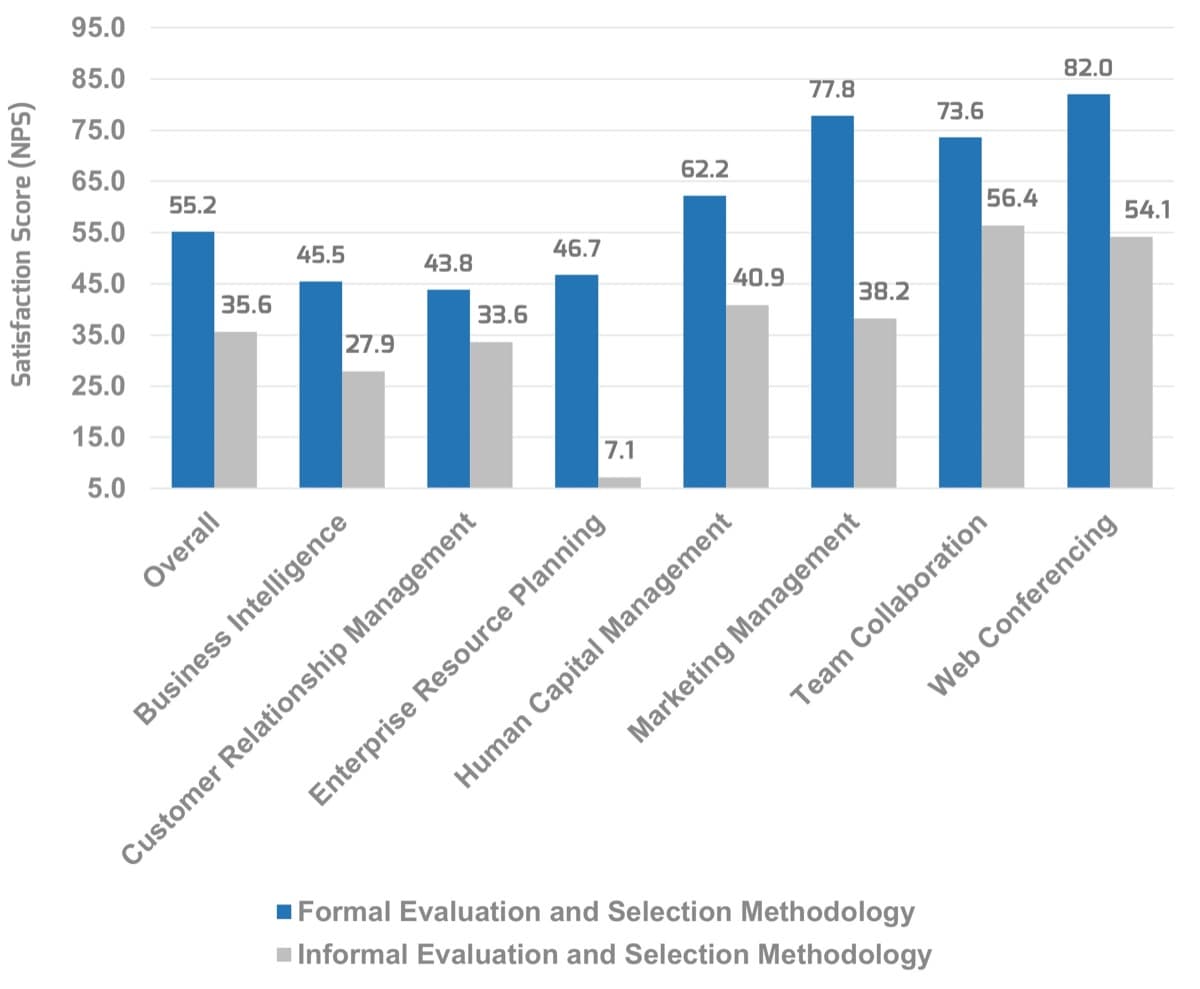
Hit a Home Run With Your Business Stakeholders
Use a data-driven approach to select the right application vendor for their needs – fast
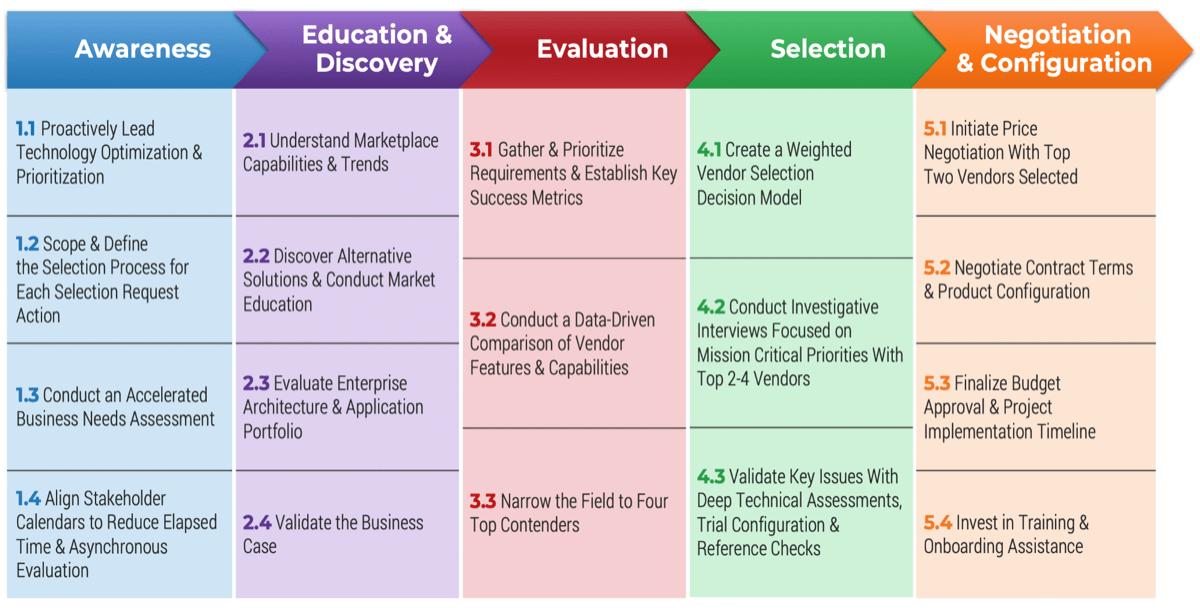
Investing time improving your software selection methodology has big returns.
Info-Tech Insight
Not all software selection projects are created equal – some are very small; some span the entire enterprise. To ensure that IT is using the right framework, understand the cost and complexity profile of the application you’re looking to select. The Rapid Application Selection Framework approach is best for commodity and mid-tier enterprise applications; selecting complex applications is better handled by the methodology described in Implement a Proactive and Consistent Vendor Selection Process.
Lock Down the Key Players Before Setting Up the Relevant Timeline
You are the quarterback of your selection team
Don’t get bogged down “waiting for the stars to align” in terms of people’s availability: if you wait for the perfect alignment, the project may never get done.
If a key stakeholder is unavailable for weeks or months due to PTO or other commitments, don’t jeopardize project timelines to wait for them to be free. Find a relevant designate that can act in their stead!
You don’t need the entire team on the field at once. Keep certain stakeholders on the bench to swap in and out as needed.
Info-Tech Insight
Assemble the key stakeholders for project kick-off to synchronize the application selection process and limit elapsed time. Getting all parties on the same page increases output satisfaction and eliminates rework. Save time and get input from key stakeholders at the project kick-off.
Assemble a Cross-Functional Team for Best Results
A blend of both worlds gets the best of both worlds from domain expertise (technical and business)
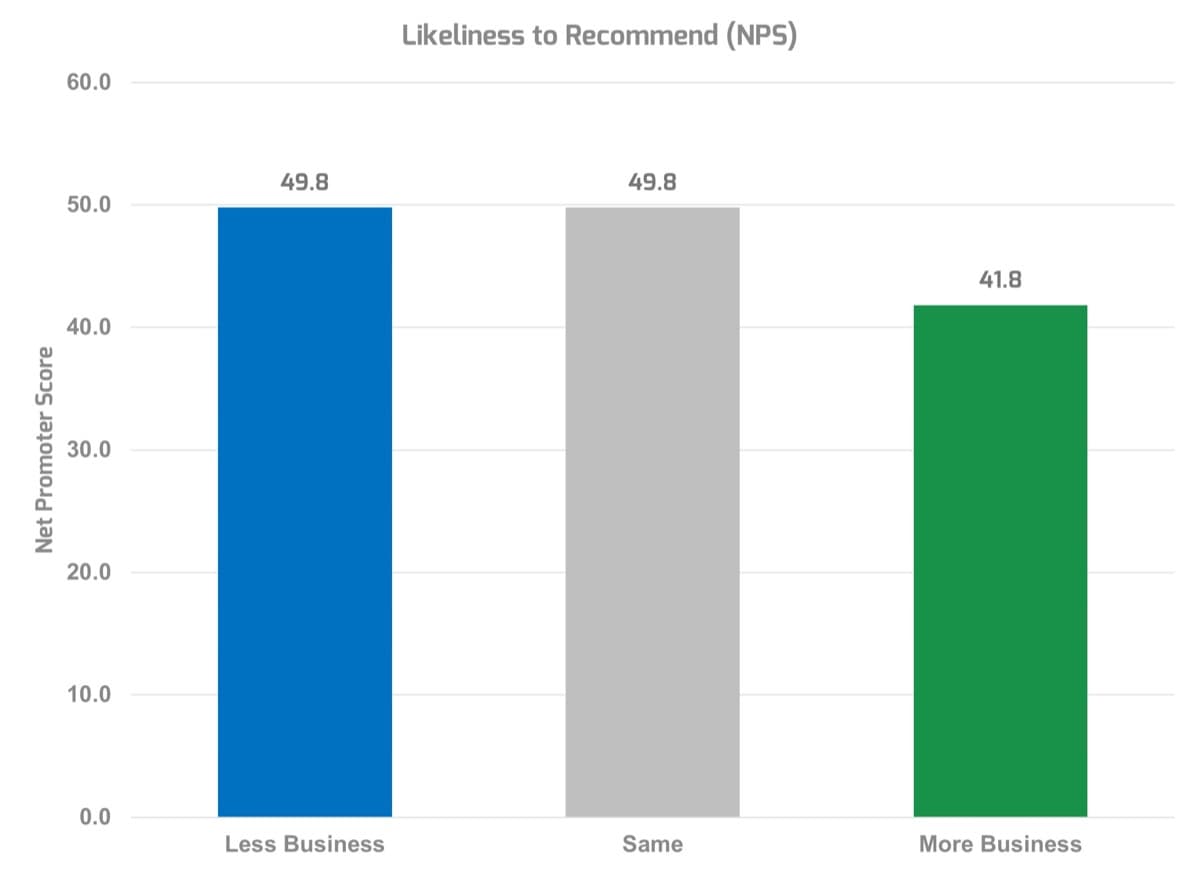
How to manage the cross-functional selection team:
- There should be a combination of IT and businesspeople involved in the selection process, and ideally the ratio would be balanced.
- No matter what you are looking for, you should never include more than five people in the selection process.
- You can keep key stakeholders and other important individuals informed with what is going on, but they don’t necessarily have to be involved in the selection process.
Leverage a Five-Person Team With Players From Both IT and the Business
For maximum effectiveness, assign at least one resource to the project on a full-time basis
IT Leader |
Technical IT |
Business Analyst/ Project Manager |
Business Lead |
Process Expert |
|---|---|---|---|---|
This team member is an IT director or CIO who will provide sponsorship and oversight from the IT perspective. |
This team member will focus on application security, integration, and enterprise architecture. |
This team member elicits business needs and translates them into technology requirements. |
This team member will provide sponsorship from the business needs perspective. |
This team member will contribute their domain-specific knowledge around the processes that the new application supports. |
Info-Tech Insight
It is critical for the selection team to determine who has decision rights. Organizational culture will play the largest role in dictating which team member holds the final say for selection decisions.
Ensure That Your Project Has the Right Mix of the Core Team and Ancillary Stakeholders
Who is involved in selecting the new application?
- Core selection team:
- The core team ideally comprises just five members.
- There will be representatives from IT and the specific business function that is most impacted by the application.
- The team is typically anchored by a business analyst or project management professional.
- This is the team that is ultimately accountable for ensuring that the project stays on track and that the right vendor is selected.
- Ancillary stakeholders:
- These stakeholders are brought into the selection project on an as-needed basis. They offer commentary on requirements and technical know-how.
- They will be impacted by the project outcome but they do not bear ultimate accountability for selecting the application.
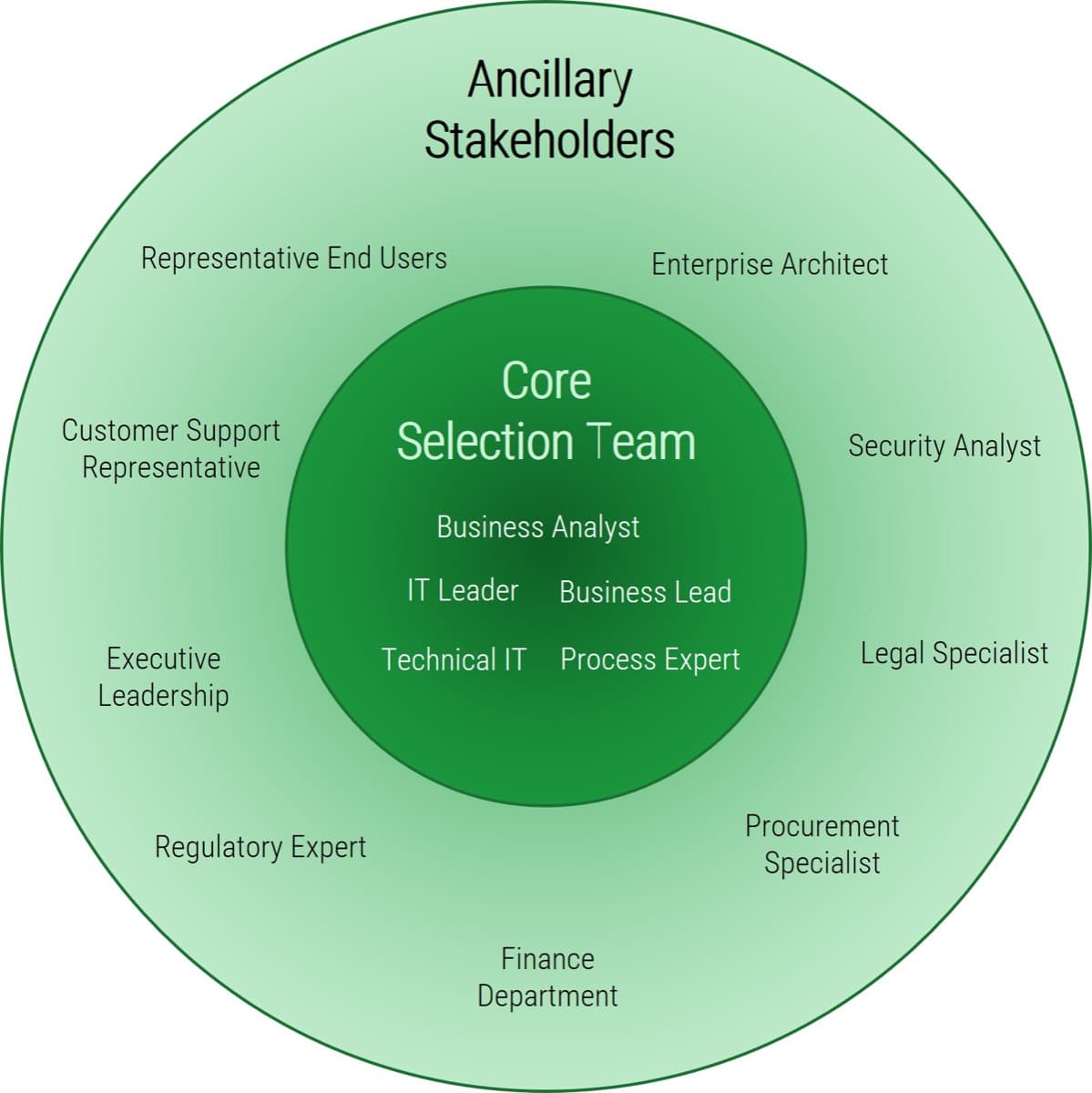
Tweak the Team Composition Based on the Application Category in Question
All applications are different. Some categories may require a slightly different balance of business and IT users.
When to adjust the selection team’s business to IT ratio:
- Increase the number of business stakeholders for customer-centric applications like customer relationship management and customer service management.
- Keep projects staffed with more technical resources when selecting internal-facing tools like network monitoring platforms, next-generation firewalls, and endpoint protection systems.
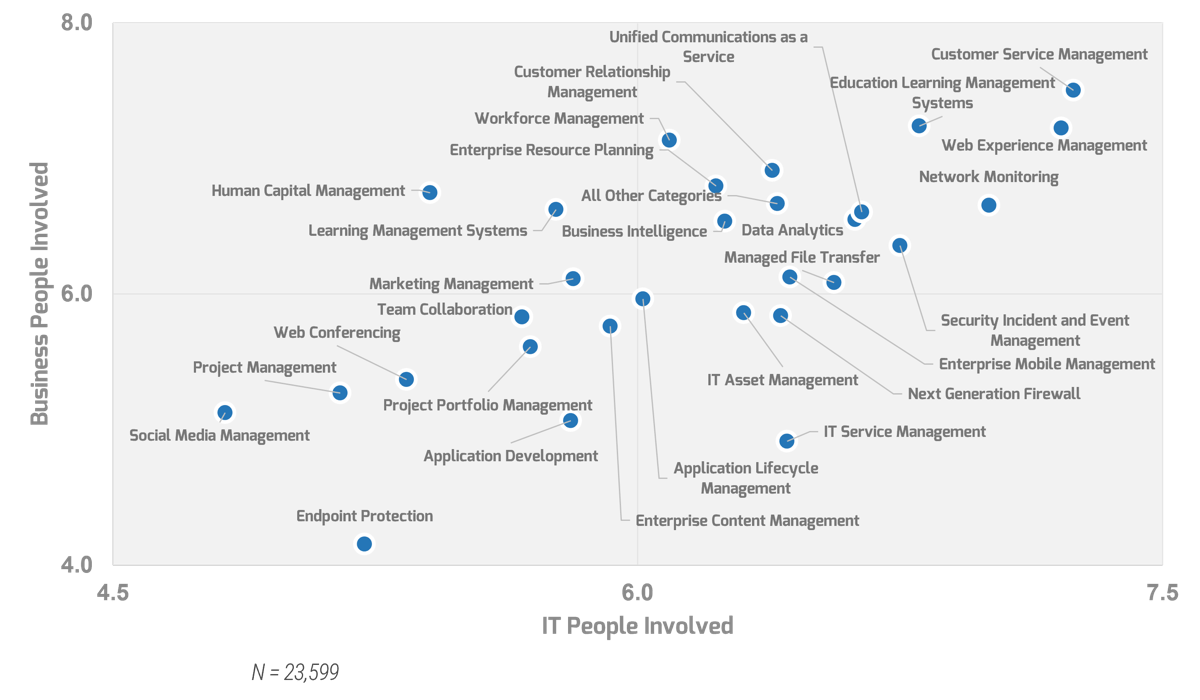
When to adjust the selection team’s business to IT ratio:
- Increase the number of business stakeholders for customer-centric applications like customer relationship management and customer service management.
- Keep projects staffed with more technical resources when selecting internal-facing tools like network monitoring platforms, next-generation firewalls, and endpoint protection systems.
Balance the Selection Team With Decision Makers and Front-Line Resources
Find the right balance!
- Make sure to include key decision makers to increase the velocity of approvals.
- However, it is critical to include the right number of front-line resources to ensure that end-user needs are adequately reflected in the requirements and decision criteria used for selection.

Info-Tech Insight
When selecting their software, organizations have an average of two to four business and IT decision makers/influencers on the core selection team.
Optimize Meeting Cadence to Complete Selection in 30 Days
Project Cadence:
- Execute approximately one phase per week.
- Conduct weekly checkpoints to move through your formal selection framework.
- Allot two to four hours per touchpoint.
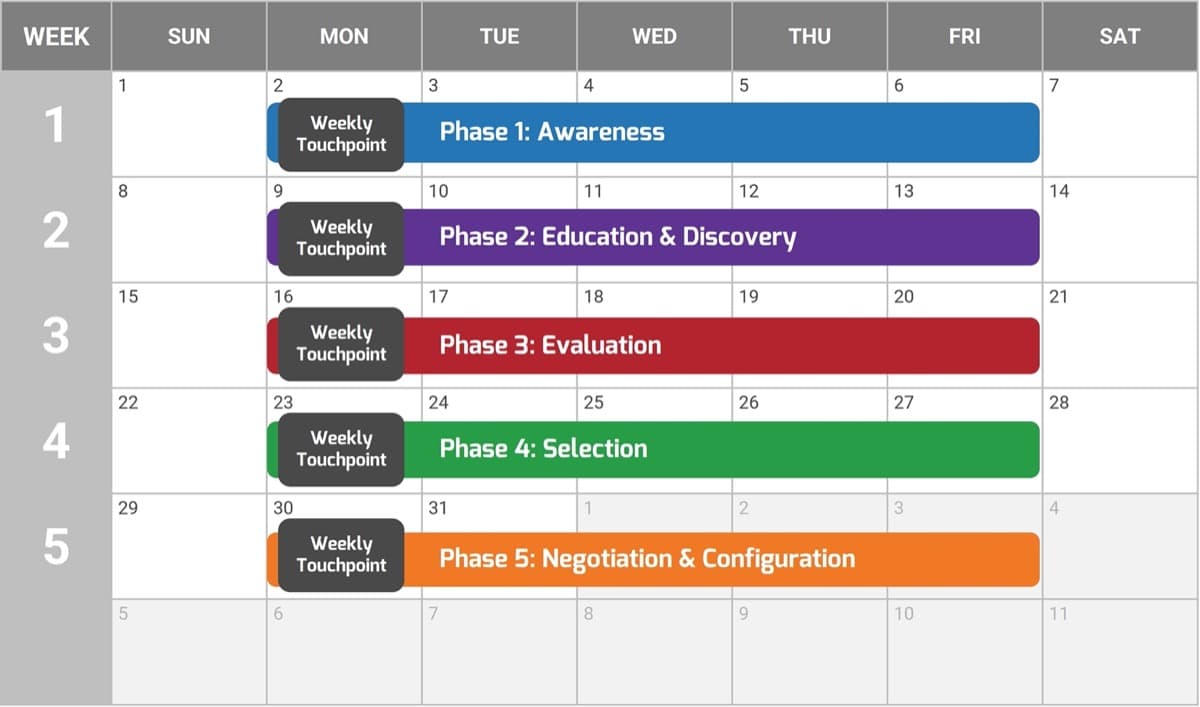
Info-Tech Insight
Use weekly touchpoints with the core selection team to eliminate broken telephone. Hold focus groups and workshops to take a more collaborative, timely, and consensus-driven approach to zero in on critical requirements.
2. Reduce Time Spent on Low-Impact Activities
✓ Reduce time spent on internet research. Leverage hard data and experts.
✓ Reduce RFP size or skip RFPs entirely.
✓ Reduce time spent watching vendor dog and pony shows.
Reduce Time Spent on Internet Research by Leveraging Hard Data and Experts
REDUCE BIAS
Taking a data-driven approach to vendor selection ensures that decisions are made in a manner that reduces human bias and exposure to misaligned incentives.
SCORING MODELS
Create a vendor scoring model that uses several different scored criteria (alignment to needs, alignment to architecture, cost, relationship, etc.) and weight them.
AGGREGATE EXPERIENCES
When you leverage services such as SoftwareReviews, you’re relying on amalgamated data from hundreds of others that have already been down this path: benefit from their experience!
PEER-DRIVEN INSIGHTS
Formally incorporate a review of Category Reports from SoftwareReviews into your vendor selection process to take advantage of peer-driven expert insights.
Contact Us
Info-Tech is just a phone call away. Our expert analysts can guide you to successful project completion at no additional cost to you.
Bloated RFPs Are Weighing You Down
Avoid “RFP overload” – parse back deliverables for smaller projects
- Many IT and procurement professionals are accustomed to deliverable-heavy application selection projects.
- Massive amounts of effort is spent creating onerous RFIs, RFPs, vendor demo scripts, reference guides, and Pugh matrices – with only incremental (if any) benefits.
- For smaller projects, focus on creating a minimum viable RFP that sketches out a brief need statement and highlights three or four critical process areas to avoid RFP fatigue.
Draft a lightweight RFI (or minimum viable RFP) to give vendors a snapshot of your needs while managing effort
An RFI or MV-RFP is a truncated RFP document that highlights core use cases to vendors while minimizing the amount of time the team has to spend building it.
You may miss out on the right vendor if:
- The RFP is too long or cumbersome for the vendor to respond.
- Vendors believe their time is better spent relationship selling.
- The RFP is unclear and leads them to believe they won’t be successful.
- The vendor was forced to guess what you were looking for.
How to write a successful RFI/MV-RFP:
- Expend your energy relative to the complexity of the required solution or product you’re seeking.
- A good MV-RFP is structured as follows: a brief description of your organization, business context, and key requirements. It should not exceed a half-dozen pages in length.
- Be transparent.
- This could potentially be a long-term relationship, so don’t try to trick suppliers.
- Be clear in your expectations and focus on the key aspects of what you’re trying to achieve.
Use the appropriate Info-Tech template for your needs (RFI, RFQ, or RFP). The Request for Information Template is best suited to the RASF approach.
If Necessary, Make Sure That You Are Going About RFPs the Right Way
RFPs only add satisfaction when done correctly
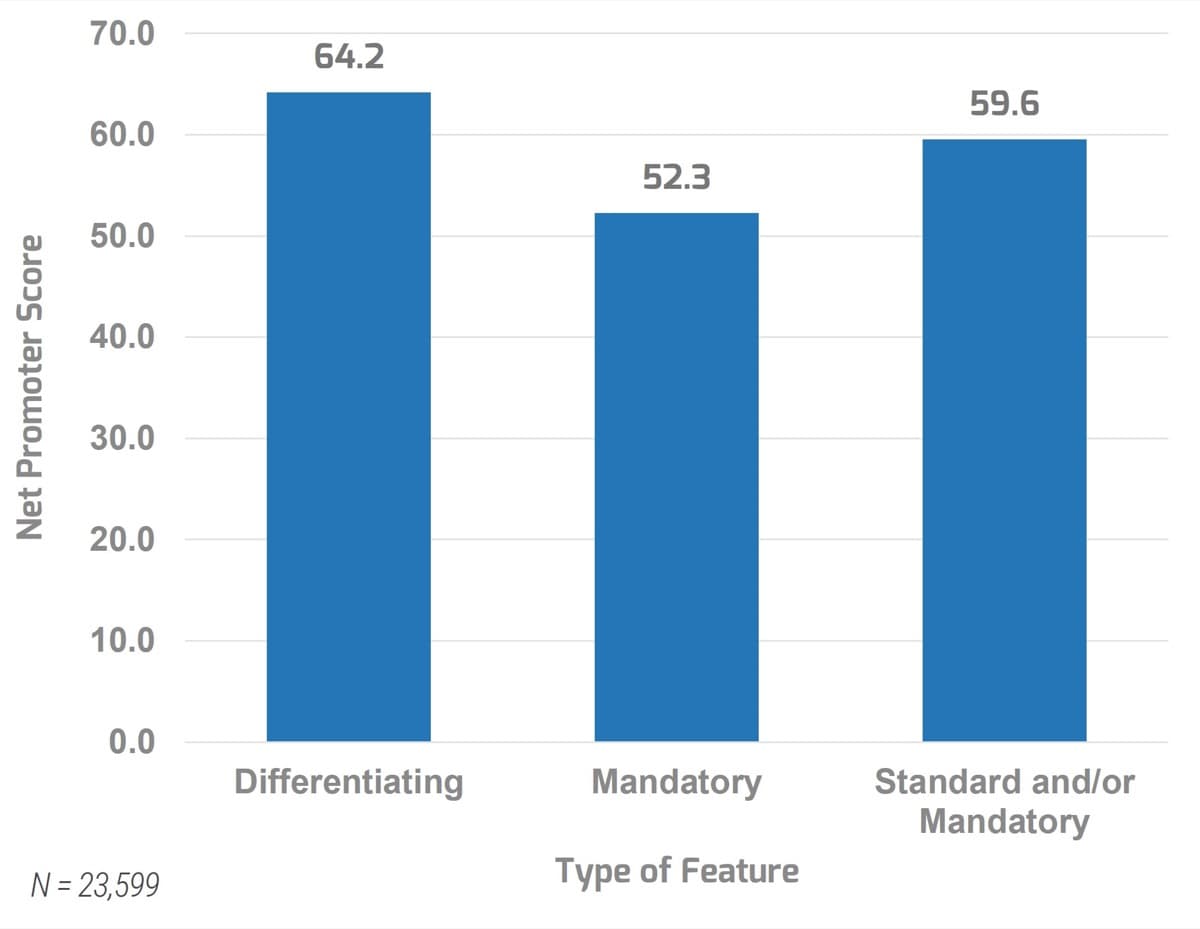
Info-Tech Insight
Prescriptive yet flexible: Avoid RFP overload when selecting customer experience–centric applications, but a formal approach to selection is still beneficial.
When will an RFP increase satisfaction?
- Satisfaction is increased when the RFP is used in concert with a formal selection methodology. An RFP on its own does not drive significant value.
- RFPs that focus on an application’s differentiating features lead to higher satisfaction with the selection process.
- Using the RFP to evaluate mandatory or standard and/or mandatory features yields neutral results.
Reduce Time Spent Watching Vendor Dog and Pony Shows
Salesperson charisma and marketing collateral quality should not be primary selection criteria. Sadly, this is the case far too often.
Use data to take control back from the vendor
- Taking a data-driven approach to vendor selection ensures that decisions are made in a manner that reduces human bias and exposure to misaligned incentives.
- When you leverage services such as SoftwareReviews, you’re relying on amalgamated data from hundreds of others that have already been down this path: benefit from their collective experience!
Kill the “golf course effect” and eliminate stakeholder bias
- A leading cause of selection failure is human bias. While rarely malicious, the reality is that decision makers and procurement staff can become unduly biased over time by vendor incentives. Conference passes, box seats, a strong interpersonal relationship – these are all things that may be valuable to a decision maker but have no bearing on the efficacy of an enterprise application.
- A strong selection process mitigates human bias by using a weighted scoring model and basing decisions on hard data: cost, user satisfaction scores, and trusted third-party data from services such as SoftwareReviews.
Conduct a Day of Rapid-Fire Investigative Interviews
Zoom in on high-value use cases and answers to targeted questions
Make sure the solution will work for your business Give each vendor 60 to 90 minutes to give a rapid-fire presentation. We suggest the following structure:
To ensure a consistent evaluation, vendors should be asked analogous questions, and a tabulation of answers should be conducted. |
How to challenge the vendors in the investigative interview
|
Rapid-Fire Vendor Investigative Interview
Invite vendors to come onsite (or join you via videoconference) to demonstrate the product and to answer questions. Use a highly targeted demo script to help identify how a vendor’s solution will fit your organization’s particular business capability needs.
Spend Your Time Wisely and Accelerate the Process
Join the B2B software selection r/evolution
Awareness | Education & Discovery | Evaluation | Selection | Negotiation & Configuration |
Reduce Time | Reduce Time | Reduce Time | Reduce Time | Reduce Time |
↓ | ↓ | ↓ | ↑ | ↑ |
Save time | Save time across tedious demos and understanding the marketplace. | Save time gathering detailed historical requirements. Instead, focus on key issues. | Use your time to validate how the solution will handle mission-critical requirements. | Spend time negotiating with two viable alternatives to reduce price by up to 50%. |
Use a tier-based model to accelerate commodity and complex selection projects.
Eliminate elapsed process time with focus groups and workshops.
3. Focus on High-Impact Activities
✓ Narrow the field to four contenders prior to in-depth comparison.
✓ Identify portfolio overlap with accelerated enterprise architecture oversight.
✓ Focus on investigative interviews and proof of concept projects.
Narrow the Field to a Maximum of Four Contenders
Focus time spent on the players that we know can deliver strong value
1. ACCELERATE SELECTION
Save time by exclusively engaging vendors that support the organization’s differentiating requirements.
2. DECISION CLARITY
Prevent stakeholders from getting lost in the weeds with endless lists of vendors.
3.CONDENSED DEMOS
Limiting the project to four contenders allows you to stack demos/investigative interviews into the same day.
4. LICENSING LEVERAGE
Keep track of key differences between vendor offerings with a tight shortlist.
Rapid & Effective Selection Decisions
Consolidating the Vendor Shortlist Up-Front Reduces Downstream Effort
Put the “short” back in shortlist!
- Radically reduce effort by narrowing the field of potential vendors earlier in the selection process. Too many organizations don’t funnel their vendor shortlist until nearing the end of the selection process. The result is wasted time and effort evaluating options that are patently not a good fit.
- Leverage external data (such as SoftwareReviews) and expert opinion to consolidate your shortlist into a smaller number of viable vendors before the investigative interview stage and eliminate time spent evaluating dozens of RFP responses.
- Having fewer RFP responses to evaluate means you will have more time to do greater due diligence.
Rapid Enterprise Architecture Evaluations Are High-Impact Activities
When accelerating selection decisions, finding the right EA is a balancing act
- Neglecting enterprise architecture as a shortcut to save time often leads to downstream integration problems and decreases application satisfaction.
- On the other hand, overly drawn out enterprise architecture evaluations can lead to excessively focusing on technology integration versus having a clear and concise understanding of critical business needs.
Info-Tech Insight
Targeting an enterprise architecture evaluation as part of your software selection process that does not delay the selection while also providing sufficient insight into platform fit is critical.
Key activities for rapid enterprise architecture evaluation include:
- Security analysis
- Portfolio overlap review + integration assessment
- Application standards check
The data confirms that it is worthwhile to spend time on enterprise architecture
- Considering software architecture fit up-front to determine if new software aligns with the existing application architecture directly links to greater satisfaction.
- Stakeholders are most satisfied with their software value when there is a good architectural platform fit.
- Stakeholders that ranked Architectural Platform Fit lower during the selection process were ultimately more unsatisfied with their software choice.
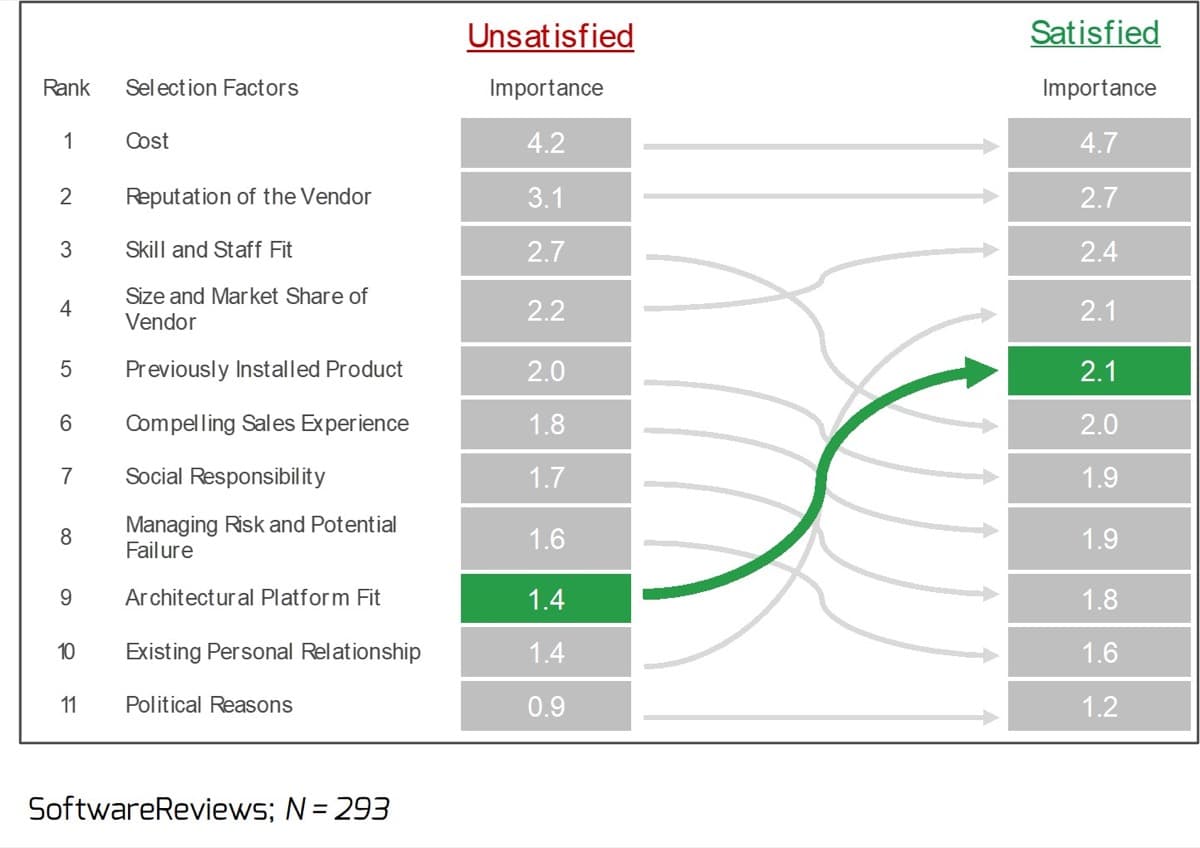
Identify Portfolio Overlap With an Accelerated Enterprise Architecture Assessment
Develop a clear view of any overlap within your target portfolio subset and clear rationalization/consolidation options
- Application sprawl is a critical pain point in many organizations. It leads to wasted time, money, and effort as IT (and the business) maintain myriad applications that all serve the same functional purpose.
- Opportunities are missed to consolidate and streamline associated business process management, training, and end-user adoption activities.
- Identify which applications in your existing architecture serve a duplicate purpose: these applications are the ones you will want to target for consolidation.
- As you select a new application, identify where it can be used to serve the goal for application rationalization (i.e. can we replace/retire existing applications in our portfolio by standardizing the new one?).
Keep the scope manageable!
- Highlight the major functional processes that are closely related to the application you’re selecting and identify which applications support each.
- The template below represents a top-level view of a set of customer experience management (CXM) applications. Identify linkages between sets of applications and if they’re uni- or bi-directional.
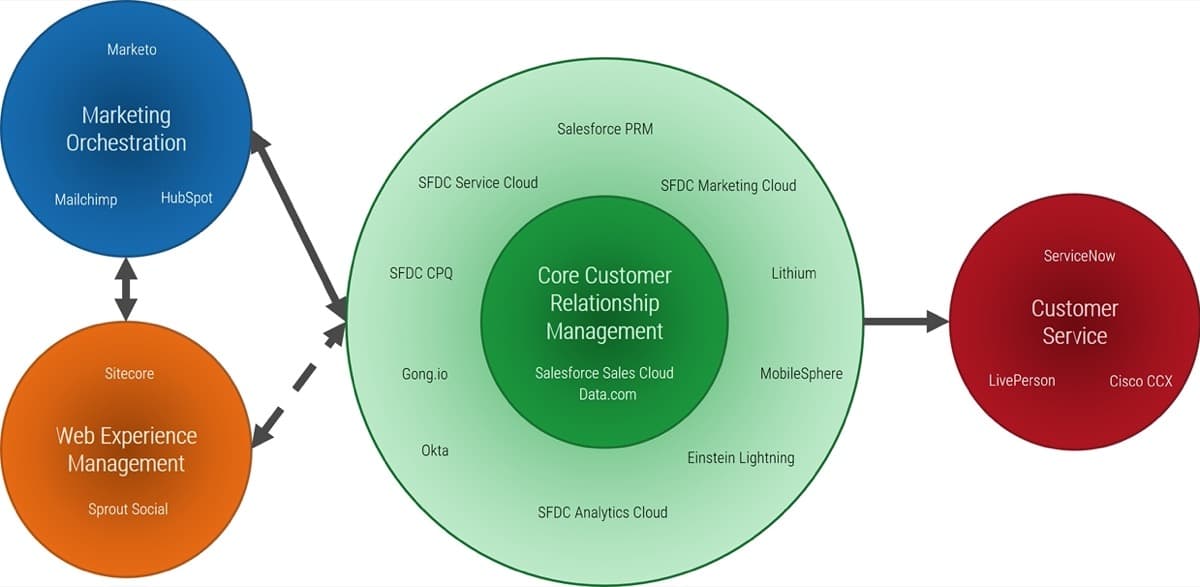
Rapidly Evaluate the Security & Risk Profile for a Right-Sized Enterprise Architecture Evaluation
There are four considerations for determining the security and risk profile for the new application
- Financial Risk
- Consider the financial impact the new application has on the organization.
- How significant is the investment in technology?
- If this application fails to meet its business goals and deliver strong return on investment, will there be a significant amount of financial resources to mitigate the problem?
- Understand the type of data that will be handled/stored by the application.
- For example, a CRM will house customer personally identifiable information (PII) and an ECM will store confidential business documentation.
- Determine the consequences of a potential breach (i.e. legal and financial).
- Consider whether the application category has a historically strong security track record.
- For example, enterprise cloud storage solutions may have a different level of vulnerability than an HRIS platform.
- Determine whether the new application requires changes to infrastructure or additional security investments to safeguard expanded infrastructure.
- Consider the ways in which the changes to infrastructure increase the vectors for security breaches.
Spend More Time Validating Key Issues With Deep Technical Assessments
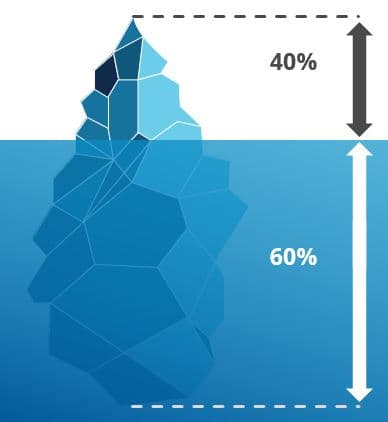
Conversations With the Vendor
- Initial conversations with the vendor build alignment on overall application capabilities, scope of work, and pricing.
Pilot Projects and Trial Environments
- Conduct a proof of concept project to ensure that the application satisfies your non-functional requirements.
- Technical assessments not only demonstrate whether an application is compatible with your existing systems but also give your technical resources the confidence that the implementation process will be as smooth as possible.
- Marketing collateral glosses over actual capabilities and differentiation. Use unbiased third-party data and detailed system training material.
4. Use Rapid & Essential Assessment Tools
✓ Focus on key use cases, not lists of features.
✓ You only need three essential tools:
- Info-Tech’s Vendor Evaluation Workbook
- The Software Selection Workbook
- A Business Stakeholder Manual
Focus on Key Use Cases, Not an Endless Laundry List of Table Stakes Features
Focus on Critical Requirements
Failure to differentiate must-have and nice-to-have use cases leads to applications full of non-critical features.
Go Beyond the Table Stakes
Accelerate the process by skipping common requirements that we know that every vendor will support.
Streamline the Quantity of Use Cases
Working with a tighter list of core use cases increases time spent evaluating the most impactful functionality.
Over-Customization Kills Projects
Eliminating dubious “sacred cow” requirements reduces costly and painful platform customization.
Only Make Use of Essential Selection Artifacts
Vendor selection projects often demand extensive and unnecessary documentation
The Software Selection Workbook
Work through the straightforward templates that tie to each phase of the Rapid Application Selection Framework, from assessing the business impact to requirements gathering.
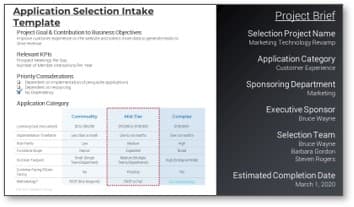
The Vendor Evaluation Workbook
Consolidate the vendor evaluation process into a single document. Easily compare vendors as you narrow the field to finalists.
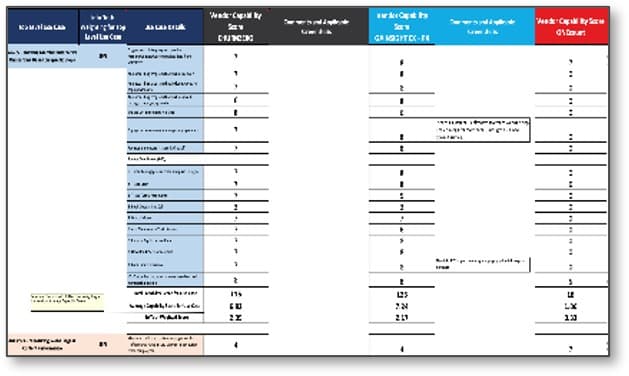
The Guide to Software Selection: A Business Stakeholder Manual
Quickly explain the Rapid Application Selection Framework to your team while also highlighting its benefits to stakeholders.
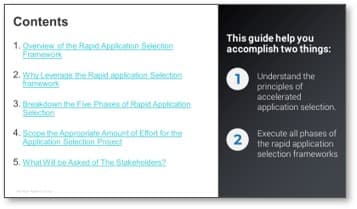
Software Selection Engagement
Five advisory calls over a five-week period to accelerate your selection process
- Expert analyst guidance over five weeks on average to select and negotiate software.
- Save money, align stakeholders, speed up the process, and make better decisions.
- Use a repeatable, formal methodology to improve your application selection process.
- Better, faster results, guaranteed, included in membership.
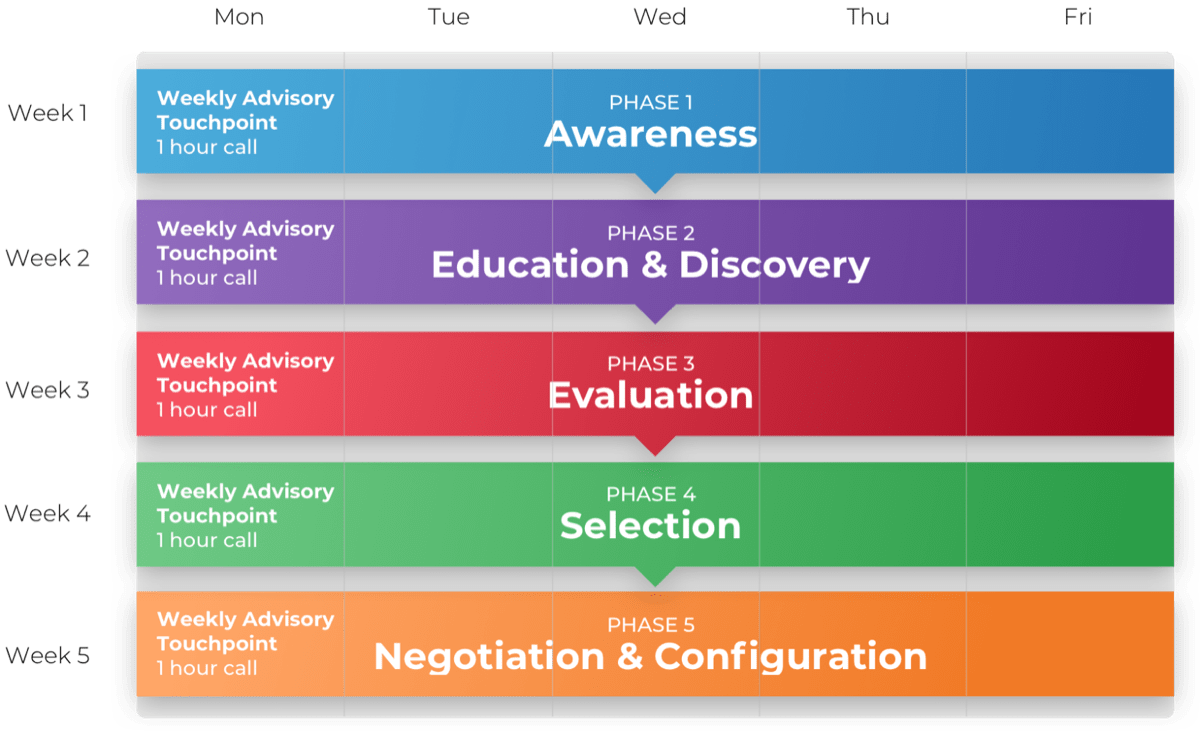
Software Selection Workshop
With 40 hours of advisory assistance delivered online, select better software, faster.
- 40 hours of expert analyst guidance.
- Project and stakeholder management assistance.
- Save money, align stakeholders, speed up the process, and make better decisions.
- Better, faster results, guaranteed; $20K standard engagement fee.

5. Select Two Viable Options & Engage Both in Negotiation
✓ Save more during negotiation by selecting two viable alternatives.
✓ Surface a consolidated list of demands prior to entering negotiation.
✓ Communicate your success with the organization.
Save More During Negotiation by Selecting Two Viable Alternatives
VENDOR 1
Build in a realistic plan B that allows you to apply leverage to the incumbent or primary vendor of choice.
VENDOR 2
If the top contender is aware that they do not have competition, they will be less inclined to make concessions.
Maintain momentum with two options
- Should you realize that the primary contender is no longer a viable option (i.e. security concerns), keeping a second vendor in play enables you to quickly pivot without slowing down the selection project.
Secure best pricing by playing vendors off each other
- Vendors are more likely to give concessions on the base price once they become aware that a direct competitor has entered the evaluation.
Truly commit to a thorough analysis of alternatives
- By evaluating competitive alternatives, you’ll get a more comprehensive view on market standards for a solution and be able to employ a range of negotiation tactics.
Focus on 5-10 Specific Contract Change Requests
Accelerate negotiation by picking your battles
ANALYZE |
DOCUMENT |
CONSOLIDATE |
PRESENT |
|---|---|---|---|
|
|
|
|
Share Stories of Cost Savings With the Organization
Secure IT’s seat at the table
Hard cost savings speak louder than words. Executive leadership will see IT as the go-to team for driving business value quickly, yet responsibly.
Build hype around the new software
Generate enthusiasm by highlighting the improved user experience provided by the new software that was has just been selected.
Drive end-user adoption
Position the cost savings as an opportunity to invest in onboarding. An application is only as valuable as your employees’ ability to effectively use it.
Keep the process rolling
Use the momentum from the project and its successful negotiation to roll out the accelerated selection approach to more departments across the organization.
Overall: The Magic Number Saves You Time and Money
Software selection takes forever. The process of choosing even the smallest apps can drag on for years: sometimes in perpetuity.
Organizations keep too many players on the field, leading to scheduling slowdowns and scope creep. |
Keeping the size of the core selection team down, while liaising with more stakeholders and subject matter experts (SMEs), leads to improved results. |
Maximize project effectiveness with a five-person team. Project satisfaction and effectiveness are stagnant or decrease once the team grows beyond five people.
Cumbersome or ad hoc selection processes lead to business-driven software selection. |
Increase stakeholder satisfaction by using a consistent selection framework that captures their needs while not being a burden. |
Empower both IT and end users with a standardized selection process to consistently achieve high satisfaction coming out of software selection projects.

Key Takeaways for Improving Your Selection Process
1. ALIGN & ELIMINATE ELAPSED TIME |
|
|---|---|
2. REDUCE TIME SPENT ON LOW-IMPACT ACTIVITIES |
|
3. FOCUS ON HIGH- IMPACT ACTIVITIES |
|
4. USE RAPID & ESSENTIAL ASSESSMENT TOOLS |
|
5. ENGAGE TWO VIABLE VENDORS IN NEGOTIATION |
|
Appendix
This study is based on a survey of 43,000 real-world IT practitioners.
- SoftwareReviews (a sister company of Info-Tech Research Group) collects and aggregates feedback on a wide variety of enterprise technologies.
- The practitioners are actual end users of hundreds of different enterprise application categories.
- The following slides highlight the supplementary data points from the comprehensive survey.
Methodology
A comprehensive study based on the responses of thousands of real-world practitioners.
Qualitative & Secondary |
Using comprehensive statistical techniques, we surveyed what our members identified as key drivers of success in selecting enterprise software. Our goal was to determine how organizations can accelerate selection processes and improve outcomes by identifying where people should spend their time for the best results. |
|---|---|
Large-n Survey |
To determine the “Magic Numbers,” we used a large-n survey: 40,000 respondents answered questions about their applications, selection processes, organizational firmographics, and personal characteristics. We used this data to determine what drives satisfaction not only with the application but with the selection process itself. |
Quantitative Drill-Down |
We used the survey to narrow the list of game-changing practices. We then conducted additional quantitative research to understand why our respondents may have selected the responses they did. |